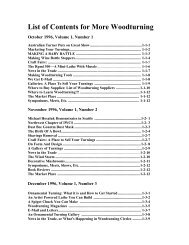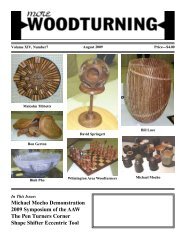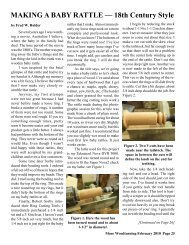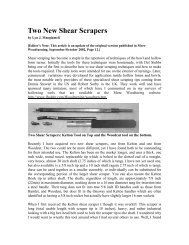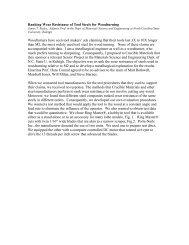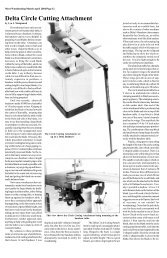Robust Lathe Review - More Woodturning
Robust Lathe Review - More Woodturning
Robust Lathe Review - More Woodturning
Create successful ePaper yourself
Turn your PDF publications into a flip-book with our unique Google optimized e-Paper software.
Vacuum Chuck Improvement to Stop Dropped Turnings When thePower Goes Out, & <strong>More</strong>by Bob Heltman, CMW, AAW ©10-2009One of these days you might befinish turning the bottom of a bowlyou have vacuum chucked, and thepower goes out. Thunderstorm.Truck hit a telephone/power pole.Backhoe snagged a power line.Fuse or circuit break blows. Sooneror later it WILL happen. Murphy’srevised law for woodturners says,“The likelihood of the power goingout unexpectedly increasesin proportion to the turning time,effort, and cost of the wood beingturned.”When it happens you haveVERY LITTLE time to react bygrabbing the object you are turningbefore it flies off the lathe and breaksor gets scarred. Or it bonks you inthe face.What to do...here’s my unfoldingstory...One technique is to put anempty tank in the vacuum linebetween the pump and your vaccumchuck. At our CMW ( www.carolinamountainwoodturners. org )club some members have found thatempty Freon tanks, about the shapeof BBQ grill tanks, but 3/5ths thePage 14 <strong>More</strong> <strong>Woodturning</strong> February 2010size, can be modified to do the job.The tank provides some extra reactiontime before your bowl comesoff the lathe. CMW Foundingmember John Hill says he therebygets about 7 seconds before thewoodturning drops. Figure 1 showsJohn’s setup, which he has mountedon a wheeled dolly.Also there are larger air tanksthat might be used, modified to storea vacuum instead of compressedair. DON’T use a tank that everhad an explodable gas in it, such aspropane!However, in my shop I havevery little spare room for anothertank anywhere near the headstockend of my lathe; my ShopVac sitsthere. So I wondered if there mightbe another approach.Somewhere in my mottledbackground I remember hearing ofcheck valves; they only allow liquidor air to flow in one direction, andpop shut automatically if the flowstops or tries to reverse. Thus IGoogled “vacuum check valve” andgot a number of hits. These valvesexist in many sizes! A few telephonecalls and emails to the salesand application engineers in two ofthose companies led to my obtaininga couple of suitable valves. The oneI needed retails at around $10.00 andsource details are in the end notes ofthis article.Figure 1. This photo showsJohn’s setup.As I slept on this project itcame to mind that if the vacuum wasTHAT tight I might need a manualbleeder valve so I could relieve thevacuum. Next came consultationwith Danny Williams of our localWilliams Hardware store. This ledto the purchase of a 1/4” Ball valve($11.00), a brass “T,” and couplings.Total $15.84. I had some Teflonplumber’s tape so the total cost ofmy experiment and modification



